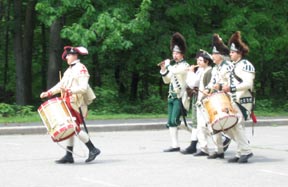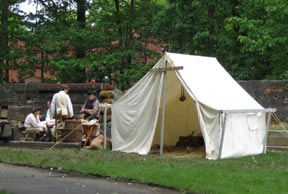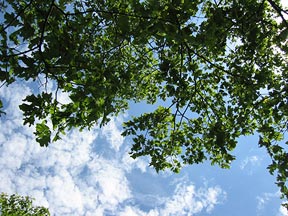Use ’em or lose ’em.
The area we lived in in New Jersey had a huge Asian population — and that means lots of good Asian restaurants: Chinese, Japanese, Korean — they were all within 10 miles of our home. In those days, we ate out several times a week and would usually hit one Asian restaurant a week.
I got very good at eating with chopsticks. I’d learned way back when, in Boston on a trip with my friend and her father. We were sixteen and her father was there on business. We stayed in a suite near the Prudential building and would wander around the city while her father was at work. One night, he took us to dinner at Benihana. That’s the touristy teppanyaki steakhouse chain. They handed chopsticks all around the table, but by the end of the meal, I was the only one still using them. Even back then I realized that you couldn’t learn something without trying.
Through the years, I got lots of practice. Whenever I went to a restaurant with a fork and a pair of chopsticks, I’d use the chopsticks. This was good, because sometimes I’d go to a restaurant where the fork was missing. Like when I worked for the New York City Comptroller’s Office right after graduating from college. My partner was Chinese, originally from Hong Kong, and on payday, we’d go to Chinatown for lunch. Lucille (my partner) didn’t go to the Chinese restaurants where the tourists went. She went where the Chinese people went. I was usually the only non-Asian in the restaurant. She’d order food and I’d eat it. Sometimes, she didn’t tell me what I was eating until after I’d had some, afraid that I wouldn’t try it if I knew what it was. But I’ll try just about anything once. She brought pigeon for lunch one day and I even tried some of that. I didn’t eat the head or the feet, both of which were still attached. I do recall asking later if it was a local pigeon — New York has lots of pigeons. It wasn’t.
Lucille used to say that every time you try something new, you add an extra day to your life. It’s something that has stuck with me since those days long ago.
Now I live in Wickenburg and chopsticks are difficult — if not downright impossible — to find. And on the rare occasion when I do eat in an Asian restaurant — usually on trips down to Phoenix or up to Prescott or out to San Francisco or New York — I’ve discovered that my chopstick skills have deteriorated. I need more practice.
I got some the other day at the Kona Grill in Scottsdale. I’d gone “down the hill” on some errands: buy food for Alex the Bird, see a lawyer, visit a jeweler, and see a doctor. Mike had some birthday gifts to exchange and the Scottsdale Fashion Center mall had all the stores he needed to hit. So we met there when I was done with my errands. By that time, I was starved — I hadn’t eaten since breakfast. Our first stop was the Kona Grill.
Understand that I’m not a big fan of chain restaurants. They tend to deliver mediocrity. This is especially apparent in the low-end restaurants — the ones where you can get a meal for under $10. I truly believe that places like Country Kitchen, for example, serve prepared foods that they heat up when you order it. Food that was prepared in some big factory and quick frozen or vacuum-packed before being shipped to the local restaurant.
Kona Grill is a chain, but it’s one that we’ll eat in. So are P.F. Chang’s, Macaroni Grill, and Outback Steakhouse. The trouble is, all the new restaurants going up are part of a chain. There are so few independent restaurants. When you find a good one (which is not easy in a place likek Phoenix), you should eat there regularly, just to preserve it. Someday soon, there won’t be any independents left.
We arrived at Kona Grill at happy hour. Mike and I aren’t big drinkers, but the happy hour menu did include half-price selected appetizers, pizzas, and sushi. So we settled at a high-top in the bar, ordered some appetizers and sushi and token drinks, and prepared for a feeding frenzy.
They gave us chopsticks, probably because we ordered sushi. Now I’ve never been to Japan, but my understanding is that in Japan, sushi is “finger food.” That is, you eat it with your hands. (If you’ve been to Japan or live in Japan now and can set me straight on this, please do use the comments link — I’m genuinely curious.) I usually use chopsticks — mostly to get practice — but I’ll use my fingers when I eat big sushi — you know, like futomaki — that you can’t stuff into your mouth at one go. I’ve found that my chopstick skills are no longer sufficient to hold together half a piece of sushi after I’ve bitten into it. (It could also be the sushi chef’s rolling skills.)
Anyway, we enjoyed a good, cheap meal and got our chopstick practice. We also got a chance to walk around a big mall that wasn’t crowded with 15-year-old, tattooed kids on cell phones.
Next week, I’ll be in Mountain View, CA with my editor, Megg. She’s already asked what kind of food I like so she can buy me dinner on the publisher. I’m hoping to get some more chopstick practice then.

 Although I enjoyed the scenery while in flight, I didn’t really know how the photos my passengers were taking were coming out. Not until Mike sent me three sample images. Here’s my favorite of the bunch, downsized for Web display.
Although I enjoyed the scenery while in flight, I didn’t really know how the photos my passengers were taking were coming out. Not until Mike sent me three sample images. Here’s my favorite of the bunch, downsized for Web display. The first treat was the re-enactment stuff going on. I don’t know if they do this every Sunday or if we just happened to stop by on the right day, but there were men in revolutionary war uniforms doing the kinds of things the soldiers did back then. Like marching around with a drum and fife. Or with guns. Or setting up a camp near the mortar lobbing area. Or building a shelter without any modern tools.
The first treat was the re-enactment stuff going on. I don’t know if they do this every Sunday or if we just happened to stop by on the right day, but there were men in revolutionary war uniforms doing the kinds of things the soldiers did back then. Like marching around with a drum and fife. Or with guns. Or setting up a camp near the mortar lobbing area. Or building a shelter without any modern tools. I don’t know why these guys were there, but they were definitely into it. Their outfits looked great — but a lot cleaner than they would have been 230 years ago. Sadly, there weren’t many spectators. The park was pretty empty. It was as if they were performing for themselves. Maybe something was going to start later on. We didn’t hang around. We had dim sum to eat.
I don’t know why these guys were there, but they were definitely into it. Their outfits looked great — but a lot cleaner than they would have been 230 years ago. Sadly, there weren’t many spectators. The park was pretty empty. It was as if they were performing for themselves. Maybe something was going to start later on. We didn’t hang around. We had dim sum to eat. We also spent some time at one of the lookouts, watching the bridge and the river flowing beneath it. I took some pictures (of course). And I can recall some of the facts that I’d read about the bridge while in my hotel room.
We also spent some time at one of the lookouts, watching the bridge and the river flowing beneath it. I took some pictures (of course). And I can recall some of the facts that I’d read about the bridge while in my hotel room. Anyway, I also took some time to lay back on the bench and look up at the sky through the leaves of an oak tree. It was nice to be among trees that were a good deal taller than I am. The area is lush with vegetation, like a jungle waiting to reclaim the land.
Anyway, I also took some time to lay back on the bench and look up at the sky through the leaves of an oak tree. It was nice to be among trees that were a good deal taller than I am. The area is lush with vegetation, like a jungle waiting to reclaim the land. But Sunday I was there.
But Sunday I was there.